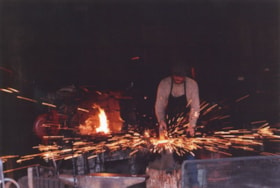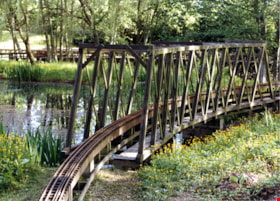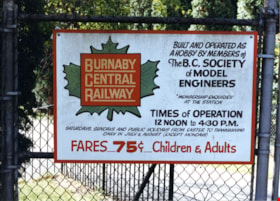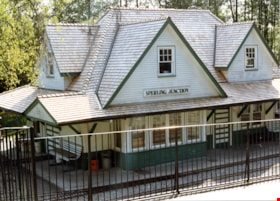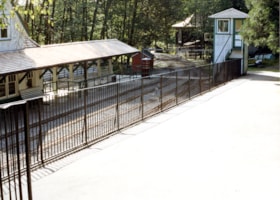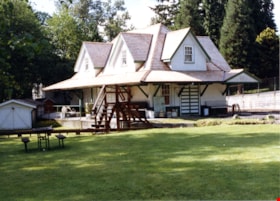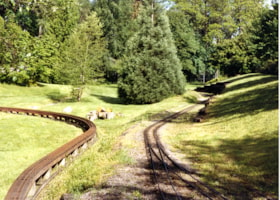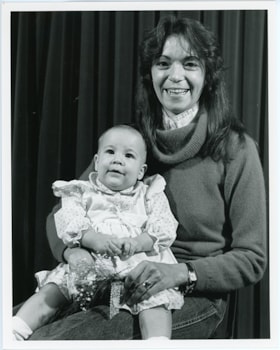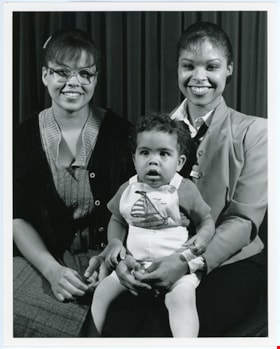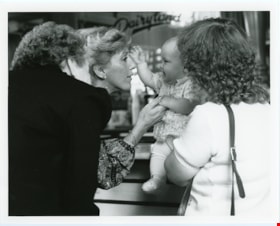Narrow Results By
Decade
- 2020s 151
- 2010s 141
- 2000s 144
- 1990s 509
- 1980s
- 1970s 892
- 1960s 208
- 1950s 291
- 1940s 499
- 1930s 493
- 1920s 432
- 1910s 457
- 1900s 376
- 1890s 105
- 1880s 25
- 1870s 14
- 1860s 12
- 1850s 5
- 1840s 3
- 1830s 3
- 1820s 3
- 1810s 3
- 1800s 3
- 1790s 3
- 1780s 3
- 1770s 3
- 1760s 3
- 1750s 3
- 1740s 3
- 1730s 3
- 1720s 3
- 1710s 3
- 1700s 3
- 1690s 3
- 1680s 3
- 1670s 3
- 1660s 3
- 1650s 3
- 1640s 3
- 1630s 3
- 1620s 3
- 1610s 3
- 1600s 3
- 1520s 1
Interview with Shushma Datt and Sudhir Datta
https://search.heritageburnaby.ca/link/museumdescription19611
- Repository
- Burnaby Village Museum
- Date
- [1946- 2023] (interview content), interviewed 20 Jan. 2023
- Collection/Fonds
- Burnaby Village Museum fonds
- Description Level
- Item
- Physical Description
- 2 sound recordings (wav) (90 min., 21 sec.) + 1 sound recording (mp3) (90 min., 4 sec.)
- Scope and Content
- Item consists of a recording of an oral history interview with Shushma Datt and her son, Sudhir Datta conducted by Burnaby Village Museum Curator, Jane Lemke and Anushay Malik. 00:00 – 12:47 Interview opens with introductions. Shushma Datt shares information about; where she’s lived in Burnaby sin…
- Repository
- Burnaby Village Museum
- Collection/Fonds
- Burnaby Village Museum fonds
- Series
- Museum Oral Histories series
- Description Level
- Item
- Physical Description
- 2 sound recordings (wav) (90 min., 21 sec.) + 1 sound recording (mp3) (90 min., 4 sec.)
- Material Details
- Interviewers: Jane Lemke and Anushay Malik Interviewees: Shushma Datt and Sudhir Datta Location of Interview: Spice Radio, Norland Avenue, Burnaby Interview Date: January 20, 2023 Total Number of tracks: 2 Total Length of all Tracks: 01:30:21 Digital master recordings (wav) were edited into one recording and converted to mp3 for access on Heritage Burnaby
- Scope and Content
- Item consists of a recording of an oral history interview with Shushma Datt and her son, Sudhir Datta conducted by Burnaby Village Museum Curator, Jane Lemke and Anushay Malik. 00:00 – 12:47 Interview opens with introductions. Shushma Datt shares information about; where she’s lived in Burnaby since immigrating in 1972 and her arranged marriage which lead her to immigrate to Canada. Datt provides detailed information about her family background in Kenya and her parent’s decision to move their family from Kenya to India in the 1960s and then to England in the 1965. Datt describes her family’s experiences living in Kenya and India in the 1960s and provides some context on the political unrest that happened in Kenya which lead her family to leave. 12:48 - 28:07 Datt talks about her time living in England and shares information on her family life and her employment experiences. Datt conveys an experience from her childhood that inspired her to become a broadcaster and shares her experiences working for the BBC oversees service in England (1965-1972). Datt describes some of the articles that she's written for various publications and the people that she's interviewed. Datt highlights a particular experience about writing a critical review about the controversial design on Jimi Hendrix’s album “Axis: Bold as Love” that depicted Hindu religious iconography. 28:09 – 34:47 Datt and Datta provide further details about Datt's arranged marriage which lead her to immigrate to Canada in 1972 and to work as a broadcaster in Canada. Datt recalls her experiences working as a radio station operator for CHQM, a radio broadcaster for CJVB and starting her own South Asian radio station Rim Jhim in 1987. 34:48 – 40:01 Datt and Datta share information on where they’ve lived in Vancouver and Burnaby. Datt and Datta recall pivotal family life events that impacted their lives in 1974. 40:02 – 45:53 Datt recalls the travel trunks and contents that she and her family brought with them when they left Nairobi. Datt describes the letters that her parents wrote. Datt and Datta describe photos of their family and convey the impacts to their family after two of Datt’s brothers died at 24 years of age. 45:54 – 50:56 Interview continues chronologically from 1974, after Datt’s son, Sudhir Datta was born. Datt describes how she had to work hard to help pay her bills and support her family. Datta describes his childhood growing up as a South Asian child living and attending school in Burnaby (1979-1992). Datt and Datta recall Datt’s graduation ceremony and Datta’s Order of British Columbia awards ceremony. 50:57 – 58:03 Datt and Datta talk about food and cooking and where they’ve shopped for traditional food supplies. Datta explains her family lineage as Hindus who eat meat and how she’s been a vegetarian for over 30 years. Datt and Datta share stories about Datt’s mother Leela Datta. 58:04 – 1:05:38 Both Datt and Datta reflect on what’s it’s been like living as South Asians in Burnaby. Datt conveys the message that she got from her mom, Leela Datta "not to assimilate but to integrate". They both reflect on how the ethnic and cultural diversity of neighbourhoods has changed over time and Datt describes his experiences as a student in Burnaby. 1:05:39 – 1:16:51 Datt and Datta talk about the role of religion in their lives, describe the purpose of Radio Rim Jhim and reflect on how the South Asian community has grown in Metro Vancouver and the disparities created within. They both recall how their lives were threatened and impacted in 1984 following an interview that Datt did with Indira Ghandhi. Datt talks about the origins of her and her son’s surnames. 1:16:52 – 1:26:11 Datt and Datta talk about and reflect on their own experiences of racism and discrimination. Datt talks about Spice Radio’s annual campaign “Raise your hands against Racism”. Datt and Datta provide background on the radio stations Rim Jhim and Spice Radio including; how they got started, their unbiased approach to broadcast content and their experiences in the complex realm of broadcasting a multi-cultural radio station. 1:26:12 – 1:30:04 In closing, Datt and Datta convey what they think that younger generations of South Asian Canadians should understand about the South Asian Community in British Columbia.
- History
- Interviewees biographies: Shushma Datt was born in Nairobi, Kenya in 1946 and is the second eldest of six children. In the 1960s during the unrest in Kenya, her family moved to India. After about nine months of living in India, Datt's family decided to return to Kenya, leaving Datt and her brother to complete their education in India. While living in India, Datt studied at Delhi University and worked at the Indian newspaper. In 1965, Datt, her parents and five siblings decided to leave Kenya and immigrated to England. While living in England, Datt got work as a broadcaster with the British Broadcasting Corporation (BBC) overseas service, producing her first program in 1969. During her time with the BBC, Datt has interviewed many influential artists including Jimi Hendrix and the Beatles as well as the Prime Minister of India, Indira Gandhi. In 1972, Datt immigrated to Canada and settled in Burnaby. In late 1973, Datt sponsored her mother who joined her in Burnaby. Datt joined the CJVB radio station in Vancouver working as the Punjabi and Hindi language broadcaster. Datt worked here until 1978 when she started her own radio station, Radio Rim Jhim. In 2005, Datt obtained her own AM radio band license for a multicultural radio station RJ1200 which was later rebranded "Spice Radio". In 2015, Datt launched Spice Radio's annual "Hands Against Racism" campaign which has won awards from the Government of British Columbia and the B.C. Association of Broadcasters. Datt has also been a producer for Omni TV and Shaw TV and was the first woman to obtain a broadcasting license from the Canadian Radio- Television Telecommunications Commission. In 1992, Shushma Datt was awarded the Order of British Columbia and is also the recipient of the Queen's Golden Jubilee Medal. Datt has been listed by the Vancouver Sun newspaper as among the 100 "most influential Indo-Canadians" and has been recognized by the Royal British Columbia Museum as one of the 150 "most influential British Columbians". Sudhir Datta is the only child of Sushma Datt and was born in Burnaby. Datta graduated with a computer science degree from Capilano University in 1995. Datta is the Vice President of Media Broadcasting (founded in 1984) creating television and radio programming for Canada's South Asian Community and has been the General Manager and Program Director of Spice Radio since 2006. Datta is also the author of many articles highlighting the South Asian community in Vancouver. Interviewers biographies: Anushay Malik is labor historian with a geographical focus on South Asia. Anushay studied at the University of London and was a research fellow at the International Institute of Social History in Amsterdam, Netherlands. In 2014, Anushay moved back to her native Pakistan and joined Lahore University of Management Services as an Assistant Professor. In 2023, Anushay is a visiting scholar at Simon Fraser University and lives in Burnaby with her family. Anushay was a co-curator of the Burnaby Village Museum exhibit “Truths Not Often Told: Being South Asian in Burnaby”. Jane Lemke has worked in various museums in the Lower Mainland and has been the Curator at Burnaby Village Museum since 2019. Her educational background includes a Master of Arts degree in History and a Master of Museum Studies degree. Her research focus has been on trauma and memory and its role in shaping Canadian identity. She loves sharing memories and stories of Burnaby with the public. Jane sits on the Council of the BC Museums Association and is the Chair of the BC Museums Association Professional Development and Education Committee.
- Creator
- Burnaby Village Museum
- Subjects
- Migration
- Occupations - Broadcasters
- Occupations - Entrepreneurs
- Occupations - Journalists
- Persons - South Asian Canadians
- Radio Stations
- Religions
- Religions - Hinduism
- Religions - Sikhism
- Social Issues
- Social Issues - Racism
- Responsibility
- Malik, Anushay
- Lemke, Jane
- Accession Code
- BV023.1.3
- Access Restriction
- No restrictions
- Reproduction Restriction
- No known restrictions
- Date
- [1946- 2023] (interview content), interviewed 20 Jan. 2023
- Media Type
- Sound Recording
- Notes
- Title based on contents of item
- Transcript available upon request
Audio Tracks
Interview with Shushma Datt and Sudhir Datta, [1946- 2023] (interview content), interviewed 20 Jan. 2023
Interview with Shushma Datt and Sudhir Datta, [1946- 2023] (interview content), interviewed 20 Jan. 2023
https://search.heritageburnaby.ca/media/hpo/_Data/_BVM_Sound_Recordings/Oral_Histories/2023_0001_0003_003.mp3Interview with Surjeet Kaur Parmar
https://search.heritageburnaby.ca/link/museumdescription19350
- Repository
- Burnaby Village Museum
- Date
- [1905-2022] (interview content), interviewed 6 Dec. 2022
- Collection/Fonds
- Burnaby Village Museum fonds
- Description Level
- Item
- Physical Description
- 2 sound recordings (wav) (75 min., 32 sec.) + 1 sound recording (mp3) (75 min., 32 sec.)
- Scope and Content
- Item consists of a recording of an oral history interview with Surjeet Kaur Parmar conducted by interviewer Anushay Malik. The interview is conducted in Urdu, Hindi and Punjabi. During the interview Surjeet Kaur Parmar provides information on; her ancestral background, family relations in India and…
- Repository
- Burnaby Village Museum
- Collection/Fonds
- Burnaby Village Museum fonds
- Series
- Museum Oral Histories series
- Description Level
- Item
- Physical Description
- 2 sound recordings (wav) (75 min., 32 sec.) + 1 sound recording (mp3) (75 min., 32 sec.)
- Material Details
- Interviewer: Anushay Malik Interviewee: Surjeet Kaur Parmar Language of Interview: Urdu, Hindi and Punjabi Location of Interview: home of Surjeet Kaur Parmar in Burnaby Interview Date: December 6, 2022 Total Number of tracks: 2 Total Length of tracks: (1:15:32) Digital master recordings (wav) were edited into one recording and converted to mp3 for access on Heritage Burnaby
- Scope and Content
- Item consists of a recording of an oral history interview with Surjeet Kaur Parmar conducted by interviewer Anushay Malik. The interview is conducted in Urdu, Hindi and Punjabi. During the interview Surjeet Kaur Parmar provides information on; her ancestral background, family relations in India and Canada, her personal experiences and her ancestors’ stories as South Asian immigrants, reflections on and personal experiences of racial discrimination as a South Asian immigrant, her places of residence, her employment background, her cultural practices and traditions including food, clothing and craft. The interview begins with introductions from interviewer Anushay Mailik. Surjeet Kaur Parmar imparts her own family’s migration story beginning with her very first elders that immigrated to Canada from India. A relative (unnamed) immigrated to Canada first and a few years later (around 1905) returned to India and brought back three cousins that included; Ginaya Singh (Ghania Singh Manhas) and Doman Singh . Mayo Singh (Ghania Singh’s younger brother) came in 1906 on his own to join them. Surjeet’s grandfather (Shair/Sher Singh Manhas) also wanted to immigrate at this time, but he was too young and weak to manage such a long trip. Surjeet conveys that while living in British Columbia, Mayo and Ginaya Singh worked together at saw mills. With their knowledge and understanding of mill work they ended up owning and operating a mill in Paldi near Duncan on Vancouver Island. At this time, most of the men from Surjeet’s family region in Punjab were abroad and with no men living at home. Mayo Singh’s father (Bhulla Singh) looked after her father (Lashman Singh Manhas) and paternal uncle (Kashmir Singh Manhas) back in Punjab. When Mayo’s father died, Mayo Singh adopted her paternal uncle (Kashmir Singh) and brought him to Canada in 1926. Surjeet describes her ancestors’ immigration journey from India to Canada. They all travelled by ship and if someone ran out of money en route, they could work on the ship. Surjeet explains that both Mayo and Ginaya Singh are Surjeet’s grandfather’s first cousins and her father’s second cousins. Surjeet recollects her grandfather (Shair/Sher Singh Manhas) saying “now that you’ve arrived there, take one cousin from each side with you”. Surjeet explains that the cousins were all from the same village in Punjab and her great grandfather wanted someone to go abroad, so he sent a few and had them bring more as the years went on. Surjeet says that she’s uncertain as to why they chose Canada rather than America but thinks that they did some form of research and determined that it was a good place to come to. Surjeet admits that she doesn’t know the name of her paternal grandfather or other elders since she never met them. Surjeet shares that it was a traditional practice to mark pots and pans with family names and imparts that she discovered her father’s name “Lashman Singh” written on the bottom of a glass. Surjeet expresses that she’s marked her own pots and pans with her name to identify which ones are hers when she gets together with family or does catering. Surjeet refers to a kohl bottle that she has and how she’d like to offer it to the museum. She explains how the kohl bottle is no longer in use but was used by her mother (Budhan Kaur Manhas) and daughter and her grandchildren. Surjeet describes a blanket that she made called a “phulkari”, now on display in a small museum in Coquitlam, a wedding shawl, that her daughter now owns and a silk sari with embroidery. Surjeet and Anushay discuss the possibility of donating the kohl bottle and the sari to the museum. Surjeet explains how the kohl is used and how her mother used to make kohl. She describes how you rub the kohl with your hands, put cardamom in it, one or two other ingredients and fill the kohl bottle up with water. Surjeet says that she used kohl as eyeliner when living in India. The interviewer asks Surjeet more about Ginaya Singh. Surjeet conveys that Ginaya Singh ended up leaving the mill on Vancouver Island and moved to Vancouver. After Ginaya Singh died from a heart attack (in 1953) his family moved from Vancouver to Burnaby. Surjeet recalls that following the death of Ginaya Singh’s youngest son, her family didn’t celebrate “Lohri” (a winter festival celebrating newborns and newly married people) for three years. She shares that she was very young at this time but remembers there being beautiful photographs of young children all dressed up and displayed in her family home. She expresses that dressing up for photos has changed over time and adds that suits didn’t really come into fashion until after the 1970s or 1980s. Surjeet conveys that her uncle named Kashmira Singh first worked at the mill in Paldi near Duncan then moved to Vancouver and opened up his own mill in North Vancouver. Surjeet’s father, Lashman Singh Manhas arrived in 1953. Surjeet expresses that Kapoor Singh was educated and worked as a manager at the mill on Vancouver Island. Surjeet recollects meeting Mayo Singh, his wife and eldest son in 1952 when they travelled to India for a cousin’s wedding. Surjeet remembers that Mayo Singh’s family had a very large house in India. She describes the house as a very opulent two story house with indoor plumbing for a bathtub, a kitchen with a woodstove, coloured mirrors, bejeweled curtains, a motor room to park cars, a buffalo and more. Surjeet refers to Nand Singh, a younger brother of Mayo Singh, who travelled from India to San Franciso and spent a year wandering around before deciding to return to India. She describes him as living in Bombay with his wife Vishan Kaur and having a transport business. Nand had two kids that came to Canada. Surjeet recollects the tragic death of Ganda Singh (Ginaya Singh) who died of a heart attack on someone’s doorstep, they thought that he was drunk so didn’t open the door. Surjeet conveys that Mayo Singh’s wife, Mission Kaur (Saradani Bishan Kaur) died while visiting India (in 1952) and that some of Mayo’s sons were married in Canada and one in India. Surjeet expresses that it was hard for Mayo’s sons to have one of their parents die in India and one die in Canada (Mayo Singh died in B.C. in 1955). Surjeet describes the hospital that Mayo built in the village of Paldi. She mentions that there were festivals and functions that took place there, there were many nurses and doctors. She recalls there being a school where their land was. She recalls that if they got headaches they were treated with medicine and that it didn’t cost much, only a six pence. Surjeet talks about her arranged marriage to Kalwant Singh "Nadeem" Parmar. Surjeet explains that her father and brother immigrated to British Columbia first (1953) and after a few months they brought Surjeet and her mother (Budhan Kaur Manhas). She recollects that when she was in Grade 10 and around 17 years of age, her family made plans to travel to India to attend a family wedding. During this time, her father suggested that it would be a good opportunity to take Surjeet with them to find her a husband in India to marry. After meeting and marrying Nadeem Parmar in India, Surjeet and Nadeem moved to England. Surjeet recollects that in order to immigrate to Canada, each family member had to pass a medical exam and how difficult it was. Her two sisters, mother and brother all had to take the test in Delhi. Surjeet recalls living in England with Nadeem. While living in England, Nadeem worked during the day and studied engineering at college in the evening. Surjeet expresses that she liked living in England and was sad to leave. While living there, they enjoyed a close knit Punjabi community and they all lived in the same area. Surjeet states later in her interview that living in Canada was different from living in England. In England, family and friends lived closer together whereas in Canada places were further apart. Surjeet says that while living in England she could walk to do her shopping. While living in England, after her children were a bit older, she worked as a seamstress in a shirt factory for a few years before coming to Canada. Surjeet imparts that her father (Lashman Singh Manhas) died of a heart attack in 1970 and her mother (Budhan Kaur Manhas) died in 1998. Her father and her family first lived in North Vancouver and then her parents bought a house on Eton Street in Burnaby, near the Ocean. After her father died, her brother and mother bought a house and moved to the Capitol Hill neighbourhood in Burnaby. In 1973, Surjeet, Nadeem and their two children immigrated to Canada and moved in with her brother and mother. Surjeet includes that her paternal aunt (Koshali Kaur Manhas) and cousins also moved to Burnaby and that her aunt and some of her cousins were sponsored by her son who came earlier. Surjeet recalls that after arriving in Canada she got work sewing in a factory located on Water Street in Gastown. Surjeet recollects travelling to her job by bus. Surjeet shares that she brought saris and quilted blankets “rijai”, not household items, in her suitcase when she came to Canada from England. Surjeet explains that the “rijai” (quilted blankets) were made from cotton from her home village in India. The blankets were made by women and then brought back to her to quilt on her sewing machine. Surjeet recalls that when she returned to Canada (in 1973 with her husband and children) they first lived with her mother and brother on Capitol Hill in Burnaby before moving to a house on Fell Avenue and then to their current home in 1982. In 1981, she worked at “Canadian Window Covering” factory making window coverings. The factory was located in the Brentwood area of Burnaby. Surjeet recalls how the factory became unionized and of how she left the factory and found union work at the Labatt’s brewery (Winery and Distillery Workers Local 300). Surjeet describes the work that she did while working at Labatt’s brewery which was located next to the Royal Columbian Hospital in Burnaby. Around 1995, when the Labatt’s factory closed down in Burnaby, she got union work as a bottle sorter for BDL Brewers Distributor Limited, where bottles were gathered for distribution at Braid Station. Surjeet left this job in 2000. Surjeet talks about traditional foods like bindi, sabji, aam and karela and where she’s shopped to find traditional ingredients for South Asian cuisine. She recollects how at first she could only find traditional ingredients at stores in Gastown, Chinatown and on Main Street in Vancouver but now they are more readily available at major grocery stores. Surjeet expresses that traditional spices and dry goods have been hard to find, apart from stores like, Famous Foods and Patels when it was located on Commercial Drive. Surjeet talks about using ingredients such as green pea flour and Besan flour to make pakoras and kahdri. Surjeet states that many immigrants didn’t wear their traditional clothing until she came later. She expresses that many South Asian immigrants didn’t wear their clothes “because there were no rights, we had to try to become like them”. Surjeet conveys that even though some were able to purchase property (she provides an example of family members in Duncan who faced discrimination by the owner/seller of a piece of property they were purchasing) that they had very little rights and they were all living in fear. She expresses that she herself didn’t experience this but in the beginning when people settled here (in B.C.) that it was very difficult. Surjeet says that when she goes to the Gurdwara and to work, she wears a sari and conveys that while working at the factory, she was encouraged to wear a sari, it was accepted then. She brought printed saris to work and her co workers said that they’d wear them to parties. Surjeet reflects on her own experiences of racism and discrimination and expresses that her generation “has learned how to stand up in front, then they got scared of saying anything”. “The people who came here first were afraid because they were alone, they had to settle down here and make a home from scratch, but the ones who came after had everything already built and made”. She explains how they helped one another when they came (to British Columbia). She describes how the Gurdwara was located on 2nd Street and all of the ships went there (new immigrants?), people would gather, get water, help one another and there would be a place for all people. Surjeet shares a personal experience of helping members of her husband’s family to immigrate to Canada. She tells of the complications of some being left behind in India and that some came to Canada as refugees that she and her husband sponsored. Surjeet expresses their struggles with raising a family, working and trying to pay for their own house while also trying to assist and support family members. Surjeet describes in detail how her husband Nadeem went back to India after his mother died to help his father, sister and her family immigrate. She explains that the immigration process took about four years and his father had to apply as a refugee. Nadeem’s sister came with her children but had to return to India so Surjeet and her family had to look after Nadeem’s sister’s child/children. Surjeet expresses that during this time she continued to work at Canadian Window Coverings, working an afternoon shift and sometimes taking her son with her. She expresses that this as a very hectic time, working the whole day, making food for everyone, grocery shopping, looking after a her sister in law’s younger child at night and getting no rest. Surjeet describes the time when she was working and her children were attending the local school. She expresses the challenges of working long days and often arriving home after her children. She recollects a time when there was a snow storm and how she was worried about her children making it home and being alone while she was at work, there were no cell phones in those days but they had phone numbers of her brother and sister. Surjeet tells of how they tried to help the rest of the Nadeem’s family immigrate including his brother who was a soccer player in India. They were able to buy a house for the whole family to live but expresses after several months Nadeem’s brother decided to stay in India. Surjeet expresses the complications and frustrations of trying to bring all family members to Canada.
- History
- Interviewee biography: Surjeet Kaur Parmar was born in Punjab, India in 1942 to parents Lashman Singh Manhas (1913-1970) and Budhan Kaur Manhas (1906-1998). Surjeet’s ancestors, Ghania Singh Manhas, Doman Singh and Mayo Singh immigrated to British Columbia in 1905 and 1906. The group got work in saw mills and soon began owning and operating their own saw mills, first in Chilliwack and Rosedale districts and later in 1920 on Vancouver Island near Duncan (Paldi) (known as the Mayo Lumber Company). In 1927, Surjeet’s paternal uncle, Kashmir Singh Manhas left Paldi, Punjab at the age of 18 years with Mayo Singh Manhas and after months of travel they arrived at Paldi on Vancouver Island. In 1953, Surjeet’s father, Lashman Singh Manhas and her two brothers immigrated to Canada and soon after brought her and her mother, Budhan Kaur Manhas. After immigrating, her father began working at “Kashmir Lumber Company” in North Vancouver which was owned by his brother Kashmira Singh Manhas. Surjeet, her parents and two brothers first made their home in North Vancouver and the 1960s they moved to 3824 Eton Street in Burnaby. In 1959, Surjeet and her family returned to India for her brother’s wedding. During this time a marriage was arranged for Surjeet to marry Nadeem Parmar and they were married in 1960. Following their marriage, Surjeet and Nadeem moved to England where they began raising their two children. While living in England, Surjeet worked as seamstress at a factory. In 1973, following the death of Surjeet’s father who died in 1970, Surjeet and Nadeem decided to immigrate to British Columbia. For the first few years, Surjeet, Nadeem and their two children lived with her mother and brother in the Capitol Hill neighbourhood of Burnaby before purchasing their own home on Fell Avenue. While living in Burnaby Surjeet has worked as a seamstress for Canadian Window Covering, Labatt's Brewery and BDL Brewers Distributor Limited which she left in 2000. In 1982, Surjeet and her family moved into a new home that they had built on Woodsworth Street where they still live today. Interviewer biography: Anushay Malik is labor historian with a geographical focus on South Asia. Anushay studied at the University of London and was a research fellow at the International Institute of Social History in Amsterdam, Netherlands. In 2014, Anushay moved back to her native Pakistan and joined Lahore University of Management Services as an Assistant Professor. In 2023, Anushay is a visiting scholar at Simon Fraser University and lives in Burnaby with her family. Anushay was a co-curator of the Burnaby Village Museum exhibit “Truths Not Often Told: Being South Asian in Burnaby”.
- Creator
- Burnaby Village Museum
- Subjects
- Buildings - Industrial - Saw Mills
- Clothing
- Crafts
- Employment
- Migration
- Social Issues
- Social Issues - Racism
- Occupations - Labourers
- Occupations - Millworkers
- Persons - South Asian Canadians
- Names
- Parmar, Surjeet Kaur
- Parmar, Kalwant Singh "Nadeem"
- Manhas, Ghania Singh
- Singh, Mayo
- Manhas, Kashmir Singh
- Manhas, Sher Singh
- Manhas, Budhan Kaur
- Manhas, Lashman Singh
- Accession Code
- BV022.29.5
- Access Restriction
- No restrictions
- Reproduction Restriction
- No known restrictions
- Date
- [1905-2022] (interview content), interviewed 6 Dec. 2022
- Media Type
- Sound Recording
- Related Material
- See also BV022.29.1 - interview with Kalwant Singh "Nadeem" Parmar
- Notes
- Title based on contents of item
- Transcription of interview translated to English from Urdu, Hindi and Punjabi to English created by Rajdeep
- Transciption available on Heritage Burnaby
- Spelling of "Ginaya Singh" found as "Ghania Singh Manhas" in obituary and death certificate
Documents
Audio Tracks
Interview with Surjeet Kaur Parmar, [1905-2022] (interview content), interviewed 6 Dec. 2022
Interview with Surjeet Kaur Parmar, [1905-2022] (interview content), interviewed 6 Dec. 2022
https://search.heritageburnaby.ca/media/hpo/_Data/_BVM_Sound_Recordings/Oral_Histories/2022_0029_0005_003.mp3Interview with "The Bollywood Boyz", Harvinder Sihra and Gurvinder Sihra
https://search.heritageburnaby.ca/link/museumdescription19608
- Repository
- Burnaby Village Museum
- Date
- [1970-2023] (interview content), interviewed 8 Jul. 2023
- Collection/Fonds
- Burnaby Village Museum fonds
- Description Level
- Item
- Physical Description
- 2 sound recordings (wav) (84 min., 14 sec.) + 1 sound recording (mp3) (62 min., 3 sec.)
- Scope and Content
- Item consists of a recording of an oral history interview with "The Bollywood Boyz", Harvinder Sihra and Gurvinder Sihra conducted by Burnaby Village Museum Registrar, Rajdeep. 00:00:00 – 00:05:26 Gurvinder “Gurv” Sihra and brother Harvinder “Harv’ Sihra introduce themselves, providing details on …
- Repository
- Burnaby Village Museum
- Collection/Fonds
- Burnaby Village Museum fonds
- Series
- Museum Oral Histories series
- Subseries
- Many Voices Project Interviews subseries
- Description Level
- Item
- Physical Description
- 2 sound recordings (wav) (84 min., 14 sec.) + 1 sound recording (mp3) (62 min., 3 sec.)
- Material Details
- Interviewer: Rajdeep Interviewees: "The Bollywood Boyz", Harvinder Sihra and Gurvinder Sihra Location of Interview: Burnaby Village Museum Interview Date: July 8, 2023 Total Number of tracks: 2 Total Length of all Tracks: 01:02:03 min Digital master recordings (wav) were recorded onto two separate audio tracks, edited and merged together and converted to mp3 for access on Heritage Burnaby Photograph credit: World Wrestling Entertainment (WWE)
- Scope and Content
- Item consists of a recording of an oral history interview with "The Bollywood Boyz", Harvinder Sihra and Gurvinder Sihra conducted by Burnaby Village Museum Registrar, Rajdeep. 00:00:00 – 00:05:26 Gurvinder “Gurv” Sihra and brother Harvinder “Harv’ Sihra introduce themselves, providing details on where they were born and grew up (in Burnaby), names of their parents and provide details on their family history. They describe how their grandparents and other relatives continued to live in Punjab after their father and mother immigrated to Canada in the 1970’s, recall the reasons their parents decided to immigrate and details of their lives before and after arriving in Canada. 00:05:27 – 00:06:46 Gurvinder and Harvinder describe some of their experiences travelling through Vancouver airport and compare their experiences with their mother’s own experiences. Gurvinder and Harvinder describe the layout of the airport and how customs and immigration has changed over time. 00:06:47 – 00:09:21 Gurvinder and Harvinder provide details about their mother, Parveen Sihra. They share information regarding her education in India and how she was unable to get work related to her degree in biology after immigrating to Canada. They convey how she worked in the Burnaby City Hall cafeteria in the 1990’s and how she worked part time in order to take care of her children. They share how their parents were proud Canadians participating in events inside and outside the South Asian community and were both fluent in English but often spoke Punjabi at home. 00:09:22 – 00:16:06 Gurvinder and Harvinder recall their childhood experiences growing up in Burnaby. They talk about the sports that they were involved with including hockey and Taekwondo, family vacations spent travelling to India and their experiences attending Marlborough Elementary School and Moscrop Secondary School.They describe how they first became interested in watching wrestling and trying it out on their own in their family home. Gurvinder and Harvinder recall their own experiences of discrimination while growing up and playing sports. 00:16:07 – 00:27:37 Gurvinder and Harvinder reflect and recall events that lead them to their dream of becoming professional wrestlers. They talk about pivotal events including attending their first live wresting event at GM Place with their father in 1996, beginning their training in Calgary in 2004, travelling across the country to participate in minor wrestling events, wrestling in Rogers Arena in 2017 and 2020 and getting their first call to join WWE. They talk about the support that they’ve had along the way to getting them where they are today and comment on why they want to be wrestlers in the WWE. 00:27:38 – 00:29:25 Gurvinder and Harvinder provide background information on their various wrestling personas and names in the world of professional wrestling including the Singh Brothers and the Bollywood Boyz. 00:29:26 – 00:38:43 Gurvinder and Harvinder talk about their experiences wrestling in India and the support and expectations of family members in becoming successful. Gurvinder and Harvinder recall and reflect on the experience of being fired from the WWE when cutbacks were made during the COVID pandemic. 00:38:44 – 00:42:53 Gurvinder and Harvinder describe what a day in their lives looks like now. They talk about how they’re still very passionate and focused on their wrestling careers and describe their experiences of having support and enthusiasm from fans and their parents. They talk about travelling across the country to particpate in different wrestling events. 00:42:54 – 00:47:18 Gurvinder and Harvinder talk about their training regimen including exercise and diet and describe areas in Burnaby where they like to train in gyms and the outdoors. 00:47:19 – 00:49:49 Gurvinder and Harvinder talk about neighbourhoods in Burnaby including Metrotown and Deer Lake and how they’ve seen them change over the years. 00:49:50 – 00:54:27 Gurvinder and Harvinder talk about their highest and lowest points in their wrestling careers, highlighting specific events. They talk about the physical stamina it takes for wrestling and compare their sport with the sport of Kabaddi (a contact team sport between two teams originating in India). 00:54:28 – 00:59:01 Gurvinder and Harvinder reflect on what toughness means to them, and what keeps them motivated to do what they do. 00:59:02 – 01:01:31 Gurvinder and Harvinder impart their words of wisdom to younger kids in chasing their passions and dreams and talk about their favourite Bollywood films and actors.
- History
- Interviewees' biographies: The Bollywood Boyz are a Canadian professional wrestling tag team composed of brothers Gurvinder "Gurv" Sihra (born in 1984) and Harvinder "Harv" Sihra (born in 1987). The pair are best known for their time in World Wrestling Entertainment (WWE) where Gurvinder and Harvinder performed under the ring names Sunil Singh and Samir Singh. They were both born and raised in Burnaby by their parents Harjeet and Parveen Sihra and attended Moscrop Secondary School. Gurvinder graduated from Douglas College where he studied criminology and has worked in loss prevention and has a third degree black belt in Taekwondo. Harvinder attended Douglas College with studies in history and has worked as a model and an actor. Both Gurvinder and Harvinder Sihra are Sikhs. Interviewer biography: Rajdeep was born and raised in the Lower Mainland and is of Punjabi (South Asian) descent. She has an Associate of Arts degree in Asian Studies from Kwantlen Polytechnic University, a Bachelor of Arts (Hons.) in Anthropology from the University of British Columbia. She is a student in the Restoration of Natural Systems program at the University of Victoria. Rajdeep works at Simon Fraser University as a Program Assistant and as a researcher with the City of Burnaby. At Burnaby Village Museum, Rajdeep contributed to the exhibit “Truths Not Often Told: Being South Asian in Burnaby”.
- Creator
- Burnaby Village Museum
- Subjects
- Education
- Migration
- Pandemics - COVID-19
- Persons - South Asian Canadians
- Religions - Sikhism
- Social Issues
- Social Issues - Discrimination
- Social Issues - Racism
- Sports
- Sports - Martial Arts
- Sports - Wrestling
- Sports - Ice Hockey
- Travel
- Names
- The Bollywood Boyz
- Sihra, Guvinder "Gurv"
- Sihra, Harvinder "Harv"
- Sihra, Harjeet
- Sihra, Parveen
- World Wrestling Entertainment "WWE"
- Moscrop Secondary School
- Marlborough Elementary School
- Metrotown
- Responsibility
- Rajdeep
- Geographic Access
- Deer Lake Park
- Accession Code
- BV023.16.12
- Access Restriction
- No restrictions
- Reproduction Restriction
- No known restrictions
- Date
- [1970-2023] (interview content), interviewed 8 Jul. 2023
- Media Type
- Sound Recording
- Photographer
- World Wrestling Entertainment "WWE"
- Notes
- Title based on contents of item
- Transcription available upon request - contact Burnaby Village Museum
Images
Audio Tracks
Interview with
Oakalla Prison collection
https://search.heritageburnaby.ca/link/museumdescription16696
- Repository
- Burnaby Village Museum
- Date
- [1974]-1991
- Collection/Fonds
- Oakalla Prison collection
- Description Level
- Fonds
- Physical Description
- 37.5 cm of textual records + 125 photographs + 1 videocassette
- Scope and Content
- Collection consists of a selection of Oakalla correctional facility records including reports, correspondence, photographs and a video tour of the death row incarceration cells inside Oakalla Prison taken by Burnaby Village Museum curator after the facility was closed. Most of the photographs docum…
- Repository
- Burnaby Village Museum
- Collection/Fonds
- Oakalla Prison collection
- Description Level
- Fonds
- Physical Description
- 37.5 cm of textual records + 125 photographs + 1 videocassette
- Scope and Content
- Collection consists of a selection of Oakalla correctional facility records including reports, correspondence, photographs and a video tour of the death row incarceration cells inside Oakalla Prison taken by Burnaby Village Museum curator after the facility was closed. Most of the photographs document Oakalla Prison in 1991 and were taken during the Open House event or when Burnaby Village Museum staff were granted access to retreive items prior to demolition. A small selection of facility photographs of site and staff are also included.
- Records are arranged into series:
- 1) Oakalla correctional facility records series
- 2) Oakalla correctional facility photographs series
- 3) Oakalla documentary photographs and video series
- History
- The Oakalla Prison Farm (also known as the Lower Mainland Regional Correctional Centre) was a model prison farm on 185 acres of land next to Deer Lake in Burnaby. The Oakalla Prison Farm opened in 1912 and was initially designed to hold 150 men and 50 women. By the 1950s, the population was well over one thousand. The prison included a working farm which included a dairy, vegetable gardens and livestock. In 1959 the last execution in British Columbia took place at Oakalla. Following a riot and mass escape in the late 1980s, poor conditions, and public outcry, Oakalla closed down in 1991. In the fall of 1991, the prison was opened up to the public whereby tours were conducted of the site. Not long after, buildings were demolished and a residential housing development took it's place. A playground now sits on the former site of the main building. In 1991, staff from Burnaby Village Museum were granted access, documenting the site prior to it's demolition. Many Oakalla artifacts and records were salvaged and accessioned into the Burnaby Village Museum's permanent collection.
- Responsibility
- Oakalla Prison Farm
- Accession Code
- BV991.45
- Date
- [1974]-1991
- Media Type
- Photograph
- Textual Record
- Moving Images
- Related Material
- See also Oakalla artifacts - BV991.45
- Arrangement
- Arrangement of records and series of this collection is based on record creators and subject that. Facility records and photographs were created and collected by Oakalla correctional facility staff and documentary photographs and a video from 1991 were created by Burnaby Village Museum staff.
- Notes
- Title based on content of collection
- Some records within this collection are closed. Contact Burnaby Village Museum for access.
Antique cars on Hill Street
https://search.heritageburnaby.ca/link/museumdescription13743
- Repository
- Burnaby Village Museum
- Date
- [198-]
- Collection/Fonds
- Century Park Museum Association fonds
- Description Level
- Item
- Physical Description
- 1 photograph : col. ; 10 x 15 cm
- Scope and Content
- Photograph of Hill Street inside Heritage Village Museum. Visitors are gathered along the street to view antique cars and buildings are decorated with red, white and blue bunting.
- Repository
- Burnaby Village Museum
- Collection/Fonds
- Century Park Museum Association fonds
- Description Level
- Item
- Physical Description
- 1 photograph : col. ; 10 x 15 cm
- Scope and Content
- Photograph of Hill Street inside Heritage Village Museum. Visitors are gathered along the street to view antique cars and buildings are decorated with red, white and blue bunting.
- Names
- Burnaby Village Museum
- Geographic Access
- Deer Lake Avenue
- Accession Code
- BV020.5.934
- Access Restriction
- No restrictions
- Reproduction Restriction
- No known restrictions
- Date
- [198-]
- Media Type
- Photograph
- Historic Neighbourhood
- Burnaby Lake (Historic Neighbourhood)
- Planning Study Area
- Morley-Buckingham Area
- Scan Resolution
- 600
- Scan Date
- 22-Sep-2020
- Scale
- 100
- Notes
- Title based on contents of photograph
Images
Auto shop
https://search.heritageburnaby.ca/link/museumdescription12969
- Repository
- Burnaby Village Museum
- Date
- 1984
- Collection/Fonds
- Century Park Museum Association fonds
- Description Level
- Item
- Physical Description
- 1 photograph : col. ; 12.5 x 12.5 cm
- Scope and Content
- Photograph of the inside of the Burnaby Village Museum Auto shop. A portion of a cash register is visible in the left corner of the photograph. A bicycle sits on top of a work bench and various wheels, tires, automotive parts and tools are displayed on shelving at the back of the shop. Automotive m…
- Repository
- Burnaby Village Museum
- Collection/Fonds
- Century Park Museum Association fonds
- Description Level
- Item
- Physical Description
- 1 photograph : col. ; 12.5 x 12.5 cm
- Scope and Content
- Photograph of the inside of the Burnaby Village Museum Auto shop. A portion of a cash register is visible in the left corner of the photograph. A bicycle sits on top of a work bench and various wheels, tires, automotive parts and tools are displayed on shelving at the back of the shop. Automotive machinery and equipment is scattered throughout the shop.
- Subjects
- Buildings - Civic - Museums
- Names
- Burnaby Village Museum
- Accession Code
- BV020.5.685
- Access Restriction
- No restrictions
- Reproduction Restriction
- No known restrictions
- Date
- 1984
- Media Type
- Photograph
- Related Material
- See b&w photograph: BV020.5.681
- Scan Resolution
- 600
- Scan Date
- 1-May-20
- Scale
- 100
- Notes
- Title based on contents of photograph
Images
Bell's building photographs subseries
https://search.heritageburnaby.ca/link/museumdescription17003
- Repository
- Burnaby Village Museum
- Date
- 1974-1995
- Collection/Fonds
- Burnaby Village Museum fonds
- Description Level
- Subseries
- Physical Description
- 96 photographs
- Scope and Content
- Subseries consists of photographs documenting the move, restoration, repairs and upgrades of the Whitechurch Hardware - Bell's Dry Goods building at it's original location on Sixth Street as well as on site at Burnaby Village Museum. Also includes exterior views of the building on site.
- Repository
- Burnaby Village Museum
- Collection/Fonds
- Burnaby Village Museum fonds
- Subseries
- Bell's building photographs subseries
- Description Level
- Subseries
- Physical Description
- 96 photographs
- Scope and Content
- Subseries consists of photographs documenting the move, restoration, repairs and upgrades of the Whitechurch Hardware - Bell's Dry Goods building at it's original location on Sixth Street as well as on site at Burnaby Village Museum. Also includes exterior views of the building on site.
- Names
- Burnaby Village Museum
- Accession Code
- BV020.5
- Access Restriction
- No restrictions
- Reproduction Restriction
- May be restricted by third party rights
- Date
- 1974-1995
- Media Type
- Photograph
- Notes
- Title based on content of subseries
Bell's restoration, upgrades and repairs subseries
https://search.heritageburnaby.ca/link/museumdescription17002
- Repository
- Burnaby Village Museum
- Date
- 1973-2012
- Collection/Fonds
- Burnaby Village Museum fonds
- Description Level
- Subseries
- Physical Description
- 10 cm of textual records + approx. 6 architectural drawings
- Scope and Content
- Subseries consists of correspondence, reports, tenders, workplans and budget information regarding the moving, restoration, repairs and upgrades to the Whitechurch Hardware - Bell's Dry Goods building on exhibit at Burnaby Village Museum.
- Repository
- Burnaby Village Museum
- Collection/Fonds
- Burnaby Village Museum fonds
- Description Level
- Subseries
- Physical Description
- 10 cm of textual records + approx. 6 architectural drawings
- Scope and Content
- Subseries consists of correspondence, reports, tenders, workplans and budget information regarding the moving, restoration, repairs and upgrades to the Whitechurch Hardware - Bell's Dry Goods building on exhibit at Burnaby Village Museum.
- Names
- Burnaby Village Museum
- Accession Code
- BV020.5
- Access Restriction
- Subject to FIPPA
- Reproduction Restriction
- Reproductions subject to FIPPA
- Date
- 1973-2012
- Media Type
- Textual Record
- Architectural Drawing
- Notes
- Title based on content of subseries
Betty Forbes and Merilynn Darbey at the Heritage Village Museum
https://search.heritageburnaby.ca/link/museumdescription5110
- Repository
- Burnaby Village Museum
- Date
- Nov. 1, 1981
- Collection/Fonds
- Burnaby Village Museum Photograph collection
- Description Level
- Item
- Physical Description
- 1 photograph : col ; copy print ; 12.5 cm x 9 cm
- Scope and Content
- Betty Forbes and Merilynn Brodie (formerly Merilynn Darbey), Century Park Museum Association President pose in front of vintage cars at the Heritage Village Museum's 10th anniversary.
- Repository
- Burnaby Village Museum
- Collection/Fonds
- Burnaby Village Museum Photograph collection
- Description Level
- Item
- Physical Description
- 1 photograph : col ; copy print ; 12.5 cm x 9 cm
- Material Details
- "Volunteers Betty and Marylin Derby" written in pen.
- Scope and Content
- Betty Forbes and Merilynn Brodie (formerly Merilynn Darbey), Century Park Museum Association President pose in front of vintage cars at the Heritage Village Museum's 10th anniversary.
- Accession Code
- BV018.26.9
- Access Restriction
- No restrictions
- Reproduction Restriction
- May be restricted by third party rights
- Date
- Nov. 1, 1981
- Media Type
- Photograph
- Scan Resolution
- 600
- Scan Date
- 12-Jun-18
- Notes
- Title based on contents of photograph
Images
Bicycle in auto shop
https://search.heritageburnaby.ca/link/museumdescription13030
- Repository
- Burnaby Village Museum
- Date
- [1987]
- Collection/Fonds
- Century Park Museum Association fonds
- Description Level
- Item
- Physical Description
- 1 photograph : b&w ; 9 x 13 cm
- Scope and Content
- Photograph of a bicycle on a work bench inside of the Burnaby Village Museum Auto Shop. Various tools are laid out on the work bench and shelving. License plates are displayed on the wall above the bicycle.
- Repository
- Burnaby Village Museum
- Collection/Fonds
- Century Park Museum Association fonds
- Description Level
- Item
- Physical Description
- 1 photograph : b&w ; 9 x 13 cm
- Scope and Content
- Photograph of a bicycle on a work bench inside of the Burnaby Village Museum Auto Shop. Various tools are laid out on the work bench and shelving. License plates are displayed on the wall above the bicycle.
- Subjects
- Transportation - Bicycles
- Names
- Burnaby Village Museum
- Accession Code
- BV020.5.701
- Access Restriction
- No restrictions
- Reproduction Restriction
- No known restrictions
- Date
- [1987]
- Media Type
- Photograph
- Scan Resolution
- 600
- Scan Date
- 5-May-20
- Scale
- 100
- Notes
- Title based on contents of photograph
- Note in blue ink on verso of photograph reads: "P87-5-21"
Images
Blacksmith at work
https://search.heritageburnaby.ca/link/museumdescription3339
- Repository
- Burnaby Village Museum
- Date
- July 1, 1983 (date of original)
- Collection/Fonds
- Burnaby Village Museum Photograph collection
- Description Level
- Item
- Physical Description
- 1 photograph : col. photocopy ; 16 x 23.5 cm
- Scope and Content
- Photograph of the blacksmith's shop at Burnaby Village Museum taken just as the blacksmith strikes his hammer, causing sparks to fly towards the camera.
- Repository
- Burnaby Village Museum
- Collection/Fonds
- Burnaby Village Museum Photograph collection
- Description Level
- Item
- Physical Description
- 1 photograph : col. photocopy ; 16 x 23.5 cm
- Scope and Content
- Photograph of the blacksmith's shop at Burnaby Village Museum taken just as the blacksmith strikes his hammer, causing sparks to fly towards the camera.
- Subjects
- Occupations - Blacksmiths
- Names
- Burnaby Village Museum
- Geographic Access
- Deer Lake Drive
- Accession Code
- BV004.35.1
- Access Restriction
- Restricted access
- Reproduction Restriction
- May be restricted by third party rights
- Date
- July 1, 1983 (date of original)
- Media Type
- Photograph
- Scan Resolution
- 600
- Scan Date
- 09-Jun-09
- Scale
- 100
- Photographer
- Low, Richard
- Notes
- Title based on contents of photograph
- 1 (framed) duplicate col. photocopy accompanying
Images
Burnaby Central Railway bridge
https://search.heritageburnaby.ca/link/museumdescription14029
- Repository
- Burnaby Village Museum
- Date
- 1988
- Collection/Fonds
- Century Park Museum Association fonds
- Description Level
- Item
- Physical Description
- 1 photograph : col. negative ; 35 mm
- Scope and Content
- Photograph of the Burnaby Central Railway bridge at Burnaby Village Museum. Railway bridge and tracks lead over a creek. Burnaby Central Railway was run by B.C. Society for Model Engineers (BCSME).
- Repository
- Burnaby Village Museum
- Collection/Fonds
- Century Park Museum Association fonds
- Description Level
- Item
- Physical Description
- 1 photograph : col. negative ; 35 mm
- Scope and Content
- Photograph of the Burnaby Central Railway bridge at Burnaby Village Museum. Railway bridge and tracks lead over a creek. Burnaby Central Railway was run by B.C. Society for Model Engineers (BCSME).
- Accession Code
- BV020.5.1057
- Access Restriction
- No restrictions
- Reproduction Restriction
- No known restrictions
- Date
- 1988
- Media Type
- Photograph
- Scan Resolution
- 600
- Scan Date
- 06-Oct-2020
- Scale
- 100
- Notes
- Title based on contents of photograph
Images
Burnaby Central Railway sign
https://search.heritageburnaby.ca/link/museumdescription14021
- Repository
- Burnaby Village Museum
- Date
- 1988
- Collection/Fonds
- Century Park Museum Association fonds
- Description Level
- Item
- Physical Description
- 1 photograph : col. negative ; 35 mm
- Scope and Content
- Photograph of sign for Burnaby Central Railway located at the Burnaby Village Museum.
- Repository
- Burnaby Village Museum
- Collection/Fonds
- Century Park Museum Association fonds
- Description Level
- Item
- Physical Description
- 1 photograph : col. negative ; 35 mm
- Scope and Content
- Photograph of sign for Burnaby Central Railway located at the Burnaby Village Museum.
- Accession Code
- BV020.5.1049
- Access Restriction
- No restrictions
- Reproduction Restriction
- No known restrictions
- Date
- 1988
- Media Type
- Photograph
- Scan Resolution
- 600
- Scan Date
- 06-Oct-2020
- Scale
- 100
- Notes
- Title based on contents of photograph
Images
Burnaby Central Railway station
https://search.heritageburnaby.ca/link/museumdescription14025
- Repository
- Burnaby Village Museum
- Date
- 1988
- Collection/Fonds
- Century Park Museum Association fonds
- Description Level
- Item
- Physical Description
- 1 photograph : col. negative ; 35 mm
- Scope and Content
- Photograph of railway tracks and station of Burnaby Central Railway at Burnaby Village Museum. Signage on station building reads "Sperling Junction". Burnaby Central Railway was run by B.C. Society for Model Engineers (BCSME).
- Repository
- Burnaby Village Museum
- Collection/Fonds
- Century Park Museum Association fonds
- Description Level
- Item
- Physical Description
- 1 photograph : col. negative ; 35 mm
- Scope and Content
- Photograph of railway tracks and station of Burnaby Central Railway at Burnaby Village Museum. Signage on station building reads "Sperling Junction". Burnaby Central Railway was run by B.C. Society for Model Engineers (BCSME).
- Accession Code
- BV020.5.1051
- Access Restriction
- No restrictions
- Reproduction Restriction
- No known restrictions
- Date
- 1988
- Media Type
- Photograph
- Scan Resolution
- 600
- Scan Date
- 06-Oct-2020
- Scale
- 100
- Notes
- Title based on contents of photograph
Images
Burnaby Central Railway station
https://search.heritageburnaby.ca/link/museumdescription14026
- Repository
- Burnaby Village Museum
- Date
- 1988
- Collection/Fonds
- Century Park Museum Association fonds
- Description Level
- Item
- Physical Description
- 1 photograph : col. negative ; 35 mm
- Scope and Content
- Photograph of railway tracks and station of Burnaby Central Railway at Burnaby Village Museum. Burnaby Central Railway was run by B.C. Society for Model Engineers (BCSME).
- Repository
- Burnaby Village Museum
- Collection/Fonds
- Century Park Museum Association fonds
- Description Level
- Item
- Physical Description
- 1 photograph : col. negative ; 35 mm
- Scope and Content
- Photograph of railway tracks and station of Burnaby Central Railway at Burnaby Village Museum. Burnaby Central Railway was run by B.C. Society for Model Engineers (BCSME).
- Accession Code
- BV020.5.1052
- Access Restriction
- No restrictions
- Reproduction Restriction
- No known restrictions
- Date
- 1988
- Media Type
- Photograph
- Scan Resolution
- 600
- Scan Date
- 06-Oct-2020
- Scale
- 100
- Notes
- Title based on contents of photograph
Images
Burnaby Central Railway station
https://search.heritageburnaby.ca/link/museumdescription14027
- Repository
- Burnaby Village Museum
- Date
- 1988
- Collection/Fonds
- Century Park Museum Association fonds
- Description Level
- Item
- Physical Description
- 1 photograph : col. negative ; 35 mm
- Scope and Content
- Photograph of the Burnaby Central Railway station building at Burnaby Village Museum. Burnaby Central Railway was run by B.C. Society for Model Engineers (BCSME).
- Repository
- Burnaby Village Museum
- Collection/Fonds
- Century Park Museum Association fonds
- Description Level
- Item
- Physical Description
- 1 photograph : col. negative ; 35 mm
- Scope and Content
- Photograph of the Burnaby Central Railway station building at Burnaby Village Museum. Burnaby Central Railway was run by B.C. Society for Model Engineers (BCSME).
- Accession Code
- BV020.5.1055
- Access Restriction
- No restrictions
- Reproduction Restriction
- No known restrictions
- Date
- 1988
- Media Type
- Photograph
- Scan Resolution
- 600
- Scan Date
- 06-Oct-2020
- Scale
- 100
- Notes
- Title based on contents of photograph
Images
Burnaby Central Railway tracks
https://search.heritageburnaby.ca/link/museumdescription14028
- Repository
- Burnaby Village Museum
- Date
- 1988
- Collection/Fonds
- Century Park Museum Association fonds
- Description Level
- Item
- Physical Description
- 1 photograph : col. negative ; 35 mm
- Scope and Content
- Photograph of the Burnaby Central Railway tracks at Burnaby Village Museum. Burnaby Central Railway was run by B.C. Society for Model Engineers (BCSME).
- Repository
- Burnaby Village Museum
- Collection/Fonds
- Century Park Museum Association fonds
- Description Level
- Item
- Physical Description
- 1 photograph : col. negative ; 35 mm
- Scope and Content
- Photograph of the Burnaby Central Railway tracks at Burnaby Village Museum. Burnaby Central Railway was run by B.C. Society for Model Engineers (BCSME).
- Accession Code
- BV020.5.1056
- Access Restriction
- No restrictions
- Reproduction Restriction
- No known restrictions
- Date
- 1988
- Media Type
- Photograph
- Scan Resolution
- 600
- Scan Date
- 06-Oct-2020
- Scale
- 100
- Notes
- Title based on contents of photograph
Images
Burnaby's best baby contest
https://search.heritageburnaby.ca/link/museumdescription16735
- Repository
- Burnaby Village Museum
- Date
- 16 Sep. 1984
- Collection/Fonds
- Century Park Museum Association fonds
- Description Level
- Item
- Physical Description
- 1 photograph : b&w ; 25.5 x 20 cm
- Scope and Content
- Photograph of an unidentified participant in the Best Baby in Burnaby Contest seated on the lap of her mother/caregiver.
- Repository
- Burnaby Village Museum
- Collection/Fonds
- Century Park Museum Association fonds
- Description Level
- Item
- Physical Description
- 1 photograph : b&w ; 25.5 x 20 cm
- Scope and Content
- Photograph of an unidentified participant in the Best Baby in Burnaby Contest seated on the lap of her mother/caregiver.
- History
- The first contest for Burnaby's Best Baby was held in September 1930. It was sponsored by the Burnaby Broadcast newspaper, with arrangements made by the Victorian Order of Nurses and judging by the Medical Health Officer and School Board doctor. The first winner was Lois Smith, who was presented with the Broadcast Trophy. A few years earlier, in 1922, a province wide "Better Babies Contest" was held at the New Westminster Exhibition. The babies were judged on their health, nutrition and physical form. Margaret Louise Lovell of Vancouver was the first prize winner of a five dollar coin. Burnaby's own Catherine Corker was another provincial winner in the nineteen twenties. In the early nineteen eighties, Burnaby Village Museum revived the contest as "Burnaby's Better Baby Contest" . The contest was run annually by Burnaby Village Museum until 1994 and was also known as "Burnaby's Best Baby Contest" and "Best Baby in Burnaby". The contest was limited to Burnaby residents who were twelve months and younger.
- Subjects
- Events - Competitions
- Names
- Burnaby Village Museum
- Accession Code
- BV020.5.1820
- Access Restriction
- No restrictions
- Reproduction Restriction
- May be restricted by third party rights
- Date
- 16 Sep. 1984
- Media Type
- Photograph
- Scan Resolution
- 600
- Scale
- 100
- Notes
- Title based on contents of photograph
Images
Burnaby's best baby contest
https://search.heritageburnaby.ca/link/museumdescription16737
- Repository
- Burnaby Village Museum
- Date
- 16 Sep. 1984
- Collection/Fonds
- Century Park Museum Association fonds
- Description Level
- Item
- Physical Description
- 1 photograph : b&w ; 25.5 x 20 cm
- Scope and Content
- Photograph of an unidentified participant in the Best Baby in Burnaby Contest seated together with two unidentified women. The baby is wearing a jumper with a sailboat embroidered on the bib and is seated on the lap of their mother/caregiver.
- Repository
- Burnaby Village Museum
- Collection/Fonds
- Century Park Museum Association fonds
- Description Level
- Item
- Physical Description
- 1 photograph : b&w ; 25.5 x 20 cm
- Scope and Content
- Photograph of an unidentified participant in the Best Baby in Burnaby Contest seated together with two unidentified women. The baby is wearing a jumper with a sailboat embroidered on the bib and is seated on the lap of their mother/caregiver.
- History
- The first contest for Burnaby's Best Baby was held in September 1930. It was sponsored by the Burnaby Broadcast newspaper, with arrangements made by the Victorian Order of Nurses and judging by the Medical Health Officer and School Board doctor. The first winner was Lois Smith, who was presented with the Broadcast Trophy. A few years earlier, in 1922, a province wide "Better Babies Contest" was held at the New Westminster Exhibition. The babies were judged on their health, nutrition and physical form. Margaret Louise Lovell of Vancouver was the first prize winner of a five dollar coin. Burnaby's own Catherine Corker was another provincial winner in the nineteen twenties. In the early nineteen eighties, Burnaby Village Museum revived the contest as "Burnaby's Better Baby Contest" . The contest was run annually by Burnaby Village Museum until 1994 and was also known as "Burnaby's Best Baby Contest" and "Best Baby in Burnaby". The contest was limited to Burnaby residents who were twelve months and younger.
- Names
- Burnaby Village Museum
- Accession Code
- BV020.5.1823
- Access Restriction
- No restrictions
- Reproduction Restriction
- May be restricted by third party rights
- Date
- 16 Sep. 1984
- Media Type
- Photograph
- Scan Resolution
- 600
- Scale
- 100
- Notes
- Title based on contents of photograph
Images
Burnaby's best baby contest
https://search.heritageburnaby.ca/link/museumdescription16738
- Repository
- Burnaby Village Museum
- Date
- 16 Sep. 1984
- Collection/Fonds
- Century Park Museum Association fonds
- Description Level
- Item
- Physical Description
- 1 photograph : b&w ; 25.5 x 20 cm
- Scope and Content
- Photograph of an unidentified participant in the Best Baby in Burnaby Contest interacting with people inside the Burnaby Village Museum Ice Cream Parlour. The baby is being held by their mother/caregiver while Burnaby Village Museum Operations Coordinator, Gilda Heath holds the baby's hand. An unid…
- Repository
- Burnaby Village Museum
- Collection/Fonds
- Century Park Museum Association fonds
- Description Level
- Item
- Physical Description
- 1 photograph : b&w ; 25.5 x 20 cm
- Scope and Content
- Photograph of an unidentified participant in the Best Baby in Burnaby Contest interacting with people inside the Burnaby Village Museum Ice Cream Parlour. The baby is being held by their mother/caregiver while Burnaby Village Museum Operations Coordinator, Gilda Heath holds the baby's hand. An unidentified person with their back to the camera is looking on from the left.
- History
- The first contest for Burnaby's Best Baby was held in September 1930. It was sponsored by the Burnaby Broadcast newspaper, with arrangements made by the Victorian Order of Nurses and judging by the Medical Health Officer and School Board doctor. The first winner was Lois Smith, who was presented with the Broadcast Trophy. A few years earlier, in 1922, a province wide "Better Babies Contest" was held at the New Westminster Exhibition. The babies were judged on their health, nutrition and physical form. Margaret Louise Lovell of Vancouver was the first prize winner of a five dollar coin. Burnaby's own Catherine Corker was another provincial winner in the nineteen twenties. In the early nineteen eighties, Burnaby Village Museum revived the contest as "Burnaby's Better Baby Contest" . The contest was run annually by Burnaby Village Museum until 1994 and was also known as "Burnaby's Best Baby Contest" and "Best Baby in Burnaby". The contest was limited to Burnaby residents who were twelve months and younger.
- Subjects
- Events - Competitions
- Names
- Burnaby Village Museum
- Accession Code
- BV020.5.1822
- Access Restriction
- No restrictions
- Reproduction Restriction
- May be restricted by third party rights
- Date
- 16 Sep. 1984
- Media Type
- Photograph
- Scan Resolution
- 600
- Scale
- 100
- Notes
- Title based on contents of photograph

![Antique cars on Hill Street, [198-] thumbnail](/media/hpo/_Data/_BVM_Images/2020/2020_0005_0934_001.jpg?width=280)
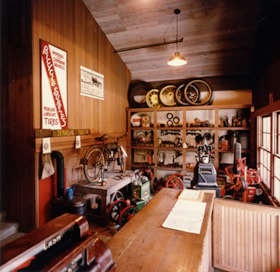
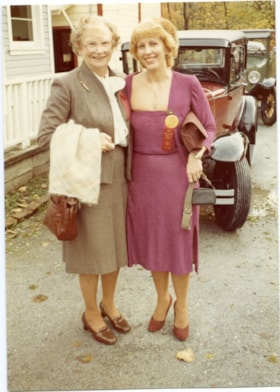
![Bicycle in auto shop, [1987] thumbnail](/media/hpo/_Data/_BVM_Images/2020/2020_0005_0701_001.jpg?width=280)
